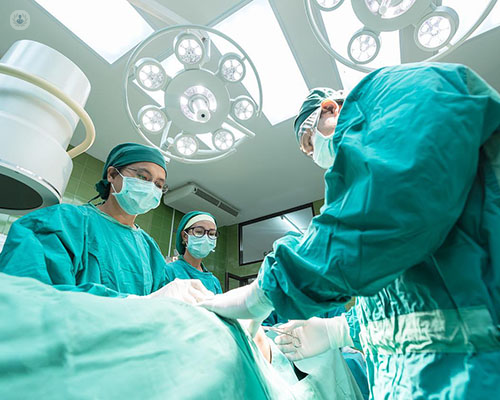Endometriosis excision: An expert answers your questions
Written in association with:Endometriosis is a very common condition that affects about 1 in 10 women in the UK. In his latest article, renowned consultant gynaecological surgeon Mr David Rowlands answers some of the most frequently asked questions regarding the condition.

When is excision of endometriosis recommended?
Endometriosis is a really common condition. This condition can affect every woman differently. Some women have very severe endometriosis but with very mild symptoms. Thus, the management of the condition depends on the woman’s symptoms and wishes, rather than the extent of the disease itself. The main problems endometriosis can cause are problems with fertility and pain.
We have different ways of managing both symptoms. Pain can be managed with pain relief medications or with treatments that can suppress endometriotic tissue or tissue in the lining of the womb so that periods can become much lighter.
Endometriosis causes heavy bleeding every cycle, leading to fibrosis and scarring, and tissues sticking together. This is why we sometimes try to remove the disease itself by excising the tissue.
The treatment for fertility problems again depends on the symptoms. Some women with endometriosis have no fertility problems, while others have severe problems. These can range from pain during intercourse, to endometriosis causing damage to the tubes and ovaries, or the chemical environment becoming toxic to the egg, sperm or embryo. Excision of endometriosis can help with fertility. IVF can also sometimes be the right choice, but women with endometriosis tend to not do as well with IVF as others.
What is the difference between excision and ablation for endometriosis?
There are two main surgical treatments for endometriosis: ablation and excision.
Ablation involves trying to destroy the disease either with diathermy or laser surgery.
Excision involves physically removing the disease.
It can be helpful to think of endometriosis like an iceberg: what we see on the surface is just a small percentage of what is there. If we destroy the disease on the surface, we are not removing the disease that is causing the symptoms.
Ablation can sometimes make excision a bit more difficult in the future, as you have hidden the disease underneath the surface with a lot of scarring on top. There has been a lot of debate for many years if excision or ablation is the right thing to do, but excision is generally considered the better option nowadays.
Does excision allow fertility preservation?
What we excise can affect fertility, so the amount of tissue excised depends on the woman’s wishes. We try to preserve as much as we can, depending on the woman’s future fertility aspirations. If the woman wants more children, we would not remove a tube or an ovary without a lot of thought and discussion. We would try to preserve as much as possible.
On the other hand, if the woman does not want more children, we might be a bit more radical and excise more tissue as this can lead to more relief from symptoms and fewer problems going forward.
If we find more disease than expected when we begin the surgery, we have the option of stopping and discussing the best way forward. Each woman should make a decision based on the facts and information available to them.
How is the excision of endometriosis performed? What are the risks involved?
Access to the disease is extremely important, and an open operation is arguably ineffective. In a laparoscopy, which involves inserting a scope into the body, we have the opportunity to look all around the abdomen, including the diaphragm and pelvis. Without a doubt, a laparoscopic procedure is the best approach.
We tend to use little pairs of scissors to remove the disease. We also use bipolar diathermy to remove the disease and control the areas of bleeding. This allows for a very precise surgery.
Over the course of my career, technology has improved greatly. This allows us to see more of the inside of the abdomen and carry out the operation more precisely. We now use 3D technology which greatly helps with depth perception and diseased tissue identification.

What is the usual recovery time after surgery?
Women undergo anaesthetic so are advised not to drive the day of the procedure or the day after. However, if they want to drive a couple of days after the procedure when the anaesthetic is out of their system, this is generally ok.
The tummy muscles will be bruised after the surgery. Everything we do depends on these muscles: coughing, breathing, moving, and sitting up. However, recovery is quite quick. I have even had one patient who won a downhill mountain biking race a week after a major laparoscopic surgery.
Is excision a permanent cure for endometriosis?
Sadly, there isn’t a cure for endometriosis. The consensus among experts is that endometriosis recurs in about a third of women, and progresses in about a third of women. Of course, we cannot know which women will have endometriosis recurrence following excision.
Mr David Rowlands is a revered consultant gynaecological surgeon with over 35 years of experience. If you would like to book a consultation with Mr Rowlands you can do so today via his Top Doctors profile.


